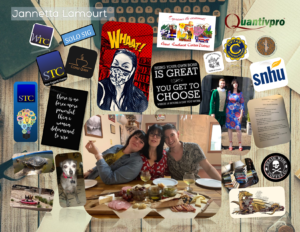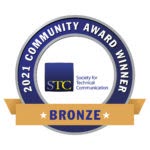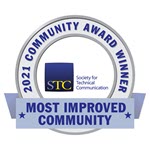Let’s get to know Jannetta!
Jannetta Lamourt is a new volunteer for the IDL SIG who is also a student at Southern New Hampshire University (SNHU). A published poet, she is pursuing a Master’s degree in English with an emphasis on creative writing.

Jannetta has taken on the role of Social Media lead for the SIG and now oversees and coordinates our public-facing communication on Twitter, Slack, Facebook, Instagram, and LinkedIn.
Although she would rather be the Head Chocolate Taster at See’s Candy factory, she really enjoys her life in technical communications. In her words, “My writing began later in life. I was around thirty when I discovered computers and the cornucopia of information called the world wide web. From there – I volunteered with a women’s org online newsletter and developed articles as needed at first, then morphed into a bylined author, and from there upon a fellow reading some of my themed articles, was asked to author a six-week adult teaching course and [found that] the world of words was my oyster!”
Jannetta works on technical writing and editing projects, writes website content and does social media consulting, guides, and other documentation. Her company name is Quantivpro (www.quantivpro.com) and maintains her own website at www.jannettalamort.com. Being self-employed, Jannetta is always looking for more work, usually on a freelance or contract basis. But, she says, if the right full-time remote position opened up… she’d be game!
Jannetta kindly took some time out of her busy student/entrepreneurial life to answer some quirky questions for our newsletter:
How would you describe your day job to a child?
I work on the computer creating stories and pictures
What’s your most memorable facepalm moment?
Discovering—after multiple self-edits and using others to edit, and after printing a thousand or so pieces—that the title had lost its contraction of “you are.” That event reigns supreme as my ultimate FP moment.
What is your motto or personal mantra?
Where there is will… there is a way.
What is your secret guilty pleasure?
A monthly subscription for Deathwish Coffee, my favorite (but not so secrete anymore)
What gets you out of bed in the morning?
Did I mention coffee? Along with a list to do a mile long, I am generally a bright-eyed and fluffy-tailed morning person!
Birthplace?
Lufkin, Texas
Currently, residing in?
Bernalillo, New Mexico (Outside Albuquerque by 18 miles, and I consider it a half-horse town because it is too small to own a whole horse.)
Associations
- IDL STC
- STC
- New-England STC
- SIG Women TechComm
- SG Solo Technical Design
- Civitan (Great Southwest Civitan District)
- Harpswell Foundation
- Jasper and Angelina Counties in Texas, Genealogy Organizations
- Quantivpro
- Sandoval County Master Gardeners
- Southern New Hampshire University
What is your most common writing error?
Commas – their ever-changing positioning debate
What is your worst pet peeve with other peoples’ writing?
- Spelling and basic errors any word processor or email software pick up – red underlines have meaning! Take a moment and tidy up.
- Wordiness, as in: I could maybe think about doing something about that issue, OR we would like to find a time to tell you perhaps what we think could be the issue… maybe.
Do you have a pet/pets?
- 16-year-old Chihuahua – Roky
- 18-year-old Aquatic Turtle- Myrtle
- One rooster and four hens
- I recently said a long goodbye to my beautiful 14-year-old Labrador Chief.
Children?
My son Conway is 26 and my daughter Nicole is 24.
Parents?
I was adopted at age three, and my adoptive parents are now deceased.
I learned about my birth parents at age ten and met them later. I also found out I am the eldest of five children in my birth family; my father is deceased, but my mother is alive at 74.
And here is Jannetta’s scrapbook page, which she designed herself:

 At the Summit Honors Reception, our IDL SIG received the Bronze-level Community Award AND the Most Improved Community Award. The Bronze citation reads:
At the Summit Honors Reception, our IDL SIG received the Bronze-level Community Award AND the Most Improved Community Award. The Bronze citation reads: This is the Most Improved citation:
This is the Most Improved citation: 

